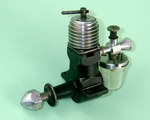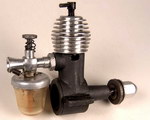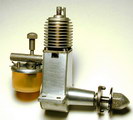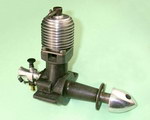Mills Bros
Serial Numbering
and Production Figures
by Adrian Duncan
For anyone interested in model engines, the issues of serial numbers and production figures must always be matters of interest, both from the standpoint of model identification and for the assessment of a given engine's relative rarity. This is as true of familiar marques such as Mills as it is of any of the less common products.
In this context, a recent analysis of Mills Brothers serial numbers has turned up some interesting information which seems to be well worth sharing. A large sample of serial numbers was assembled to form the basis for this study. For their assistance in this regard, we're most grateful to the late Roger Schroeder, the late Ivor F, Tim Dannels, David Owen, Adrian Duncan, Bert Streigler, Nick Brooks, Dave Campling, Paul Rossitter, Peter Scott, Peter Coleman, Stan Pilgrim and even the late Peter Chinn. Apologies to anyone whom we may have missed fro this long list ...
The serial numbers applied to the Mills engines consist of two elements which were consistently stamped in two separate locations. A two-digit number generally appears on the LH lug, with a two or three-digit number on the RH. The fact that the numbers were split in this way strongly implies that the makers saw the two elements of the overall number as somehow distinct.
One possible explanation which has been credibly suggested for this distinctness is that the two digit number may in a sense have been a "batch number" and that the three-digit number indicated the engine's sequential location within that batch. If this is the case (and it is mere speculation at this point), then Mills would have been in effect viewing themselves as making the engines in batches of 1000 units. The two digit number could have been applied to a given batch of 1000 cases in advance of assembly (a simple repetitive task), in which case the other three digits would have been applied to the opposite lug after assembly to place the individual engine within its batch.
Regardless of the truth of the above matter, it seems almost certain that a specific number range was assigned to each distinct model or series of Mills engines. For example, the original Mk I Mills 1.3cc diesel seems to have been allotted 0-15000. Since we see no numbers below 1746 in a fairly large sample, the actual numbering in this case may have started at 1500 to give the impression that early sales were very buoyant. Later engine types were allotted different ranges of numbers, eg, the Mk II Mills .75� being assigned the range 40,000 and greater.
If this is how things were organized, the result would be in effect a straight sequential numbering system within a specific range for each distinct model, with a two-digit number on one lug being the thousands numerator and a three-digit number on the other to indicate the engine's position within that particular batch of 1000 engines. The fact that this is exactly what we observe lends credibility to the above numbering scenario.
The following table summarizes the serial number ranges reported to date for the various Mills models, together with the implied production figures for the various models. The production dates have been derived from a combination of contemporary articles and Mills Brothers advertisements. It is hoped that this table may help both collectors and fliers to identify what they have more accurately.
| Model | Production | Sno range | Comments |
|---|---|---|---|
| 1.3 Mk I | June 1946 - May 1948 | 1746 - 14838 (25 samples) | The original model with aluminium alloy case. The sole Mills product at this time. The numbering may have been started at 1000 or 1500 to promote an impression of large early sales. Either way, these numbers imply a total production of around 14,000 units over a 23 month period - a respectable average of over 600 units per month. The significant gap in the numbers between this and the following model remains an anomaly for which we have no explanation at present! |
| 1.3 Mk II-A | June 1948 - February 1950 | 19016 - 26459 (10 samples) | The original magnesium case version of the engine. Had a higher induction port, resulting in a more restricted induction period. The implied production of 7500 units over a 20 month period suggests a production rate of 375 units monthly. The drop from the previous model is doubtless due to the fact that by this time they were concurrently manufacturing the .75 model. |
| 1.3 Mk II-B | March 1950 - 1964 | 26460 - 38537 (48 samples) | Identical to the previous model apart from a lower induction port, which increased the induction period and yielded a higher performance. Survived right through to the 1964 termination of Mills production. Around 13,000 examples made. The implied average production rate of around 90 units monthly must have been far higher at the outset. Even so, the Mills .75 clearly became the dominant model very early on. |
| .75 Mk I | October 1948 -April 1949 | 33503 - 36322 (15 samples) | Short-lived companion to the Mills 1.3 Mk I-A, built along the same lines. Only about 3,000 examples appear to have been manufactured over perhaps a 7 month production period - an average of some 430 units monthly. The totals for the concurrent 1.3 model suggest that Mills production was fairly steady at around 650 units monthly at this time, split between the two models. |
| .75 Mk II | May 1949 -1964 | 41564 - 90451 (62 samples) | Replacement for the original model, having simplified construction. Survived to the end of Mills production in 1964. Around 50,000 examples appear to have been made for an average production rate of around 280 per month - doubtless this was far higher at the outset. |
| 2.4 | February 1949 - July 1951 | 45010 - 47467 (28 samples) | Short-lived disc-valve model, which failed to match its contemporaries in performance terms. Only around 2,500 examples seem to have been made over a 29 month production period, implying that these engines were made sporadically in batches as the rather limited demand dictated. |
There are a number of obvious anomalies in the above data, such as the gap in the sequence between the Mk I and Mk II variants of the Mills 1.3. There are also a few reported numbers which do not fit the above sequence, whether by accident or intentional omission being unclear.
Nonetheless, an analysis of the above data implies that the Mills numbering system was basically sequential—unlike the E.D. system the numbers do not include any actual indication of dates of manufacture of a given engine. Even so, the numbering system used does appear to give us a chronological picture of Mills Brothers' manufacturing activities. Moreover, the size of the available sample is such that the estimated production figures are probably quite close.
During the early years, Mills production seems to have held fairly steady at around 650 units monthly. This number evidently declined over the years leading up to the final cessation of Mills model engine manufacture.
We hope that the many aficionados of these fine little engines, both collectors and fliers, may find this data useful.





